October 31, 2016
Insights from Visual Storytelling Summit 2016
It was our first Summit in partnership with The Idea Center at Miami-Dade College, dedicated to a topic that is mostly discussed in the context of entertainment and photography. Yes, there have been some discussions about visual storytelling in the context of marketing, but they tend to revolve around how to run an effective Instagram campaign or just covering general guidelines of making your message more human, authentic and visually pleasing.
How our event was different?
Us, at the Visual Storytelling Institute, the Summit organizer, see things a bit different. We recognize that the communication landscape is currently marked by two opposing forces; on one hand, a staggering explosion in content (4.6B content pieces are produced daily according to LinkedIn) and decreasing attention spans (close to zero per University of Miami Professor, Milica Mormann and Summit speaker), on the other. This conflict leaves businesses struggling to get their voices heard, and, in our opinion, this serves as the primary call for adventure for visual storytelling. Why? Our brain is wired to process visual content much faster than text and also to respond better to information packaged as stories vs. facts and stats. As such, we find the convergence of a structured storytelling and visual media as a platform for a whole new ecosystem that demands a new type of visual literacy.
With this premise in mind, we developed our Summit programming strategy to reflect diverse voices that can shed light on this new ecosystem and how marketers and entrepreneurs can take advantage to grow their companies.
Here are some top insights from our speakers:
We opened the day with an introduction from Lenardo Finol, Executive Director at The Idea Center, Miami-Dade College – one of the hottest innovation hubs in Miami – that hosted our Summit.
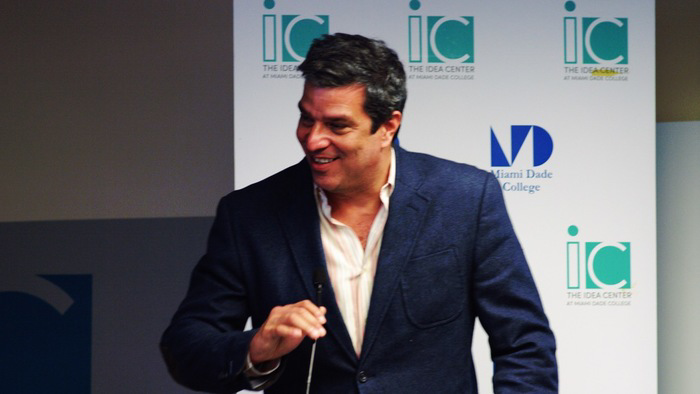
Lenardo Finol, Executive Director at The Idea Center, Miami-Dade College
(photo by Ville Ailio)
In line with the The Idea Center’s mission of helping entrepreneurs bring their ideas to life, we are excited to host the Visual Storytelling Summit 2016 in partnership with VSI.”
– Lenardo Finol, Executive Director at The Idea Center, Miami-Dade College
For context, Miami-Dade College is the second largest university in the country, boasting 160,000 students. Leandro reviewed an impressive roster of programs The Idea Center has rolled out since its inception two years ago an impressive roster of programs; from Design Thinking, Lean Startup, Codepro, Digital Marketing to VSI’s upcoming 12-week Visual Storytelling workshop starting January 2017.
Every company is a Storytelling Company
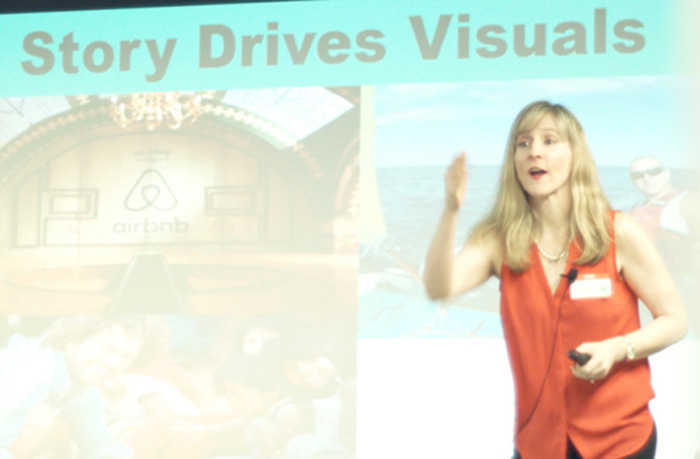
Kathy Klotz-Guest, Founder, Keeping it Human (photo by Ville Ailio)
When you tear down 4th wall and engage with people, you make magic.”
– Kathy Klotz-Guest, Founder, Keeping it Human
Kathy, our keynote speaker, effectively illustrated all the primary drivers for a compelling business storytelling while underscoring the importance of first defining your business story and then your visual strategy. The simplicity of her message coupled with creative interactive drills – totally engaged our audience. It was as if she said: “Hey, don’t just take my word for it, try it yourself.” The co-creation drill where paired attendees were asked to share their individual passions into a new idea – was a fantastic example of putting the audience in the driving seat of the experience, and demonstrating their innate storytelling power. We all learned a lot!
The Role of Attention in Visual Marketing
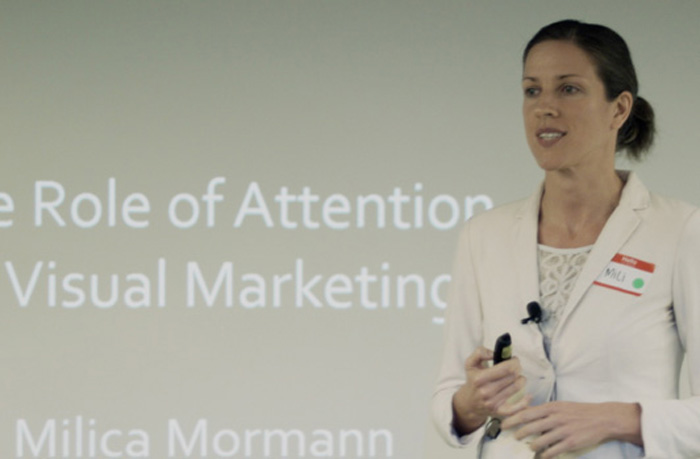 Milica Mormann, Visual Marketing Researcher, University of Miami (photo by Ville Ailio)
Milica Mormann, Visual Marketing Researcher, University of Miami (photo by Ville Ailio)
“The science of visual storytelling: Of 11M bits of info we receive per second, 10M are visual. How many bits do we process? Only 40!”
– Milica Mormann, Visual Marketing Researcher, University of Miami
Milica offered a unique perspective about visual storytelling by sharing a fascinating scientific evidence to the role of attention in driving decision making; from a glance, gaze to engage. The information was in perfect alignment with the audience expectations. It had a ton of practical intelligence like attention span is actually zero vs. 8 seconds as that overused goldfish stat has been claiming. I especially liked the fact about the importance of pre-existing interest beyond visuals – to drive attention. This would mean, that if you’re shopping for new bicycles – you’ll most likely notice bicycles everywhere you go (AKA search salience) vs. someone with a zero interest.
The Role of Authenticity in Video Storytelling
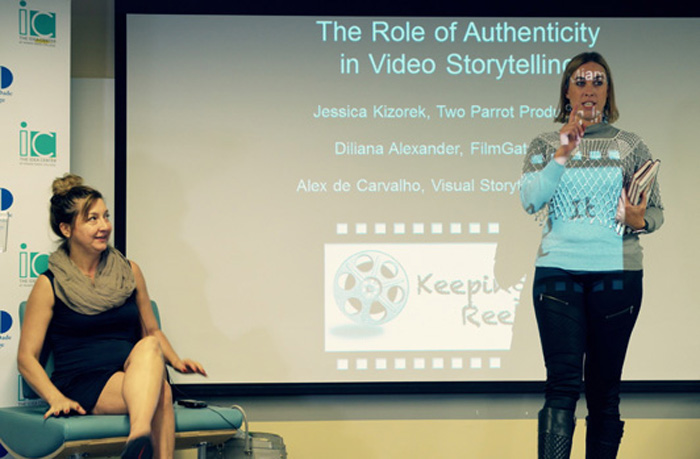 Jessica Kizorek, Partner, Two Parrot Productions &
Jessica Kizorek, Partner, Two Parrot Productions &
Diliana Alexander, Executive Director, FilmGate Miami (photo by Ville Ailio)
Use video to make viewers feel like they know you before they even meet you in person.”
–Jessica Kizorek, Partner, Two Parrot Productions
Nothing has been invented since Shakespeare. How would you tell your story in a new way?”
– Diliana Alexander, Executive Director, FilmGate Miami
Authenticity is a loaded topic that most business leaders still don’t know how to handle. With the high accessibility of creating videos on-the-go and its growing importance, our panelists’ insights and vivid examples helped demonstrate the do’s and don’ts of this critical visual format. With all the talk about rustic, imperfect videos to convey an authentic message, there is a clear line where amateurish executions can do more damage than help.
Why Visual Storytelling?
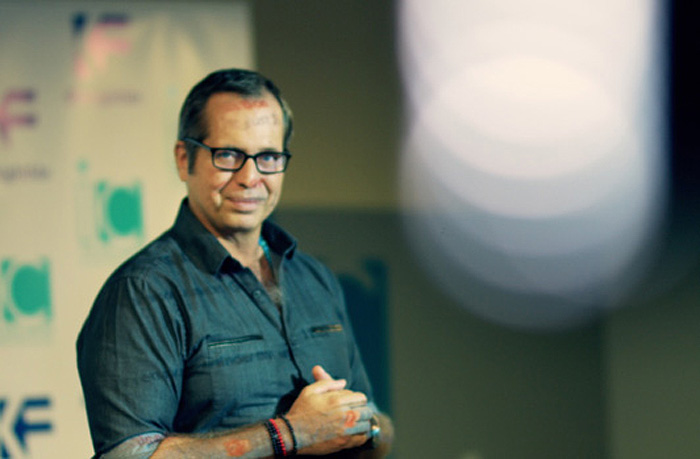 Alex de Carvalho, co-founder, Visual Storytelling Institute (photo by Ville Ailio)
Alex de Carvalho, co-founder, Visual Storytelling Institute (photo by Ville Ailio)
We swim in stories without knowing it, how to connect to them emotionally gives meaning to our lives.”
–Alex de Carvalho, co-founder, Visual Storytelling Institute
My partner in crime, Alex, did a phenomenal job covering why visual storytelling is so effective. He provided a comprehensive review of how two disciplines; visual media and storytelling converge in our brain for maximum impact. His tips offered our audience actionable advice on how to develop a sound visual storytelling strategy. I especially liked his tip, about showing the “backstage” of your story. Typically, that’s where the narrative is more interesting as you see how the story is developed including imperfections, vs. the iron out, finished product.
Snapchat: Respect the Ghost! Why Snapchat is the Ultimate Storytelling and Advertising Tool Available
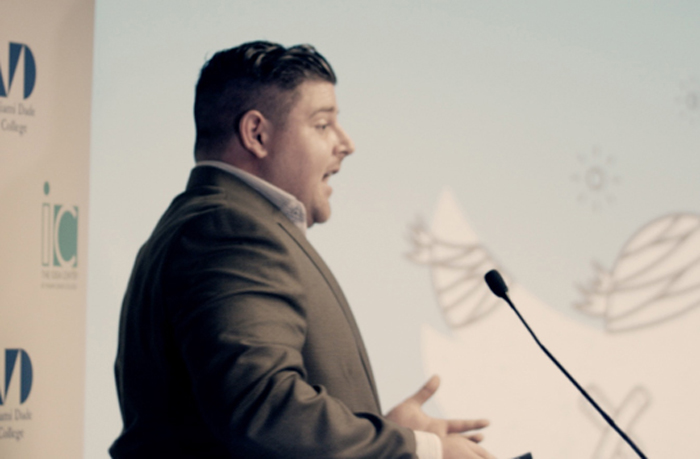 Brett Lindstrom, Lead Product Designer & Owner, CBS Sports & Lindstrom Creative
Brett Lindstrom, Lead Product Designer & Owner, CBS Sports & Lindstrom Creative
(photo by Ville Ailio)
Geo filters think of them as a campaign.”
–Brett Lindstrom, Lead Product Designer & Owner, CBS Sports & Lindstrom Creative
Brett provided a deep-dive review of Snapchat. He explored what Snapchat is, what it started out as, and what it will become. He also talked through how to create the right narrative for your brand, company or product. He also discussed key features how to use them properly and how to think about this technology from the ground up. His presentation literally captivated our audience as the topic is both hot and challenging to many, due to Snapchat’s less intuitive UI for older demographics. I really liked his presentation style that combined a value-added information delivered in a very entertaining way.
PR in the Age of Visual Storytelling
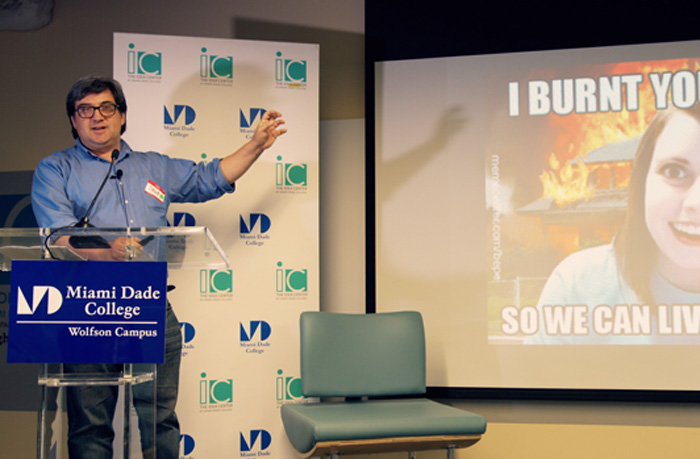 David Parmet, Owner, PR and Social Media Consultant, David Parmet Marketing & Public Relations
David Parmet, Owner, PR and Social Media Consultant, David Parmet Marketing & Public Relations
(photo by Ville Ailio)
Not enough PR people are using social media to pitch stories.”
– David Parmet, Owner, PR and Social Media Consultant, David Parmet Marketing & Public Relations
David a PR veteran, offered a fresh angle into a discipline that as he aptly said, “constantly reinventing itself.” The transition from the flat press release to cross-media experiences along with new ways of connecting with and engaging journalists through social media – brought a whole new set of perspectives. The Internet has changed how public relations does business. Now it’s no longer enough to send a press release or pitch email. Stories need to be illustrated using video and imagery to communicate. Public relations professionals need to become content creators, versed in the technology and skilled in creating compelling materials.
The Power of Visual Storytelling
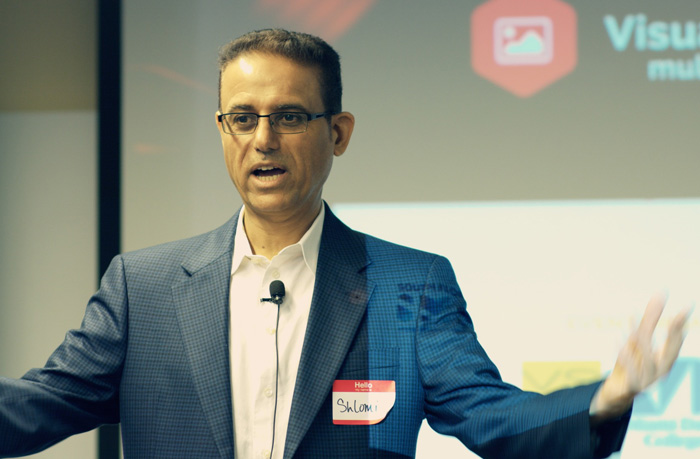 Shlomi Ron, co-founder, Visual Storytelling Institute (photo by Ville Ailio)
Shlomi Ron, co-founder, Visual Storytelling Institute (photo by Ville Ailio)
Do you remember when Content Marketing launched in 2005, but it wasn’t called Content Marketing? Visual Storytelling is the most important next step in effectively navigating the Visual Web.
–Shlomi Ron, co-founder, Visual Storytelling Institute
I provided our vision for visual storytelling. Some of it, is in the above introduction. The drivers for the current content explosion: Global Internet adoption, the emergence of social media and adoption of mobile devices. I also reviewed the evolution of storytelling frameworks from the early 1880’s to our homegrown 9-Step Visual Storytelling Framework. The visual storytelling examples, such as the 2013’s Dove Real Beauty Sketches’ campaign – helped our audience to see the principles I talked about come to life. Finally, I presented how the visual storytelling ecosystem looks like to paint a clear picture of the space and the opportunities it holds.
An Entrepreneur’s Journey
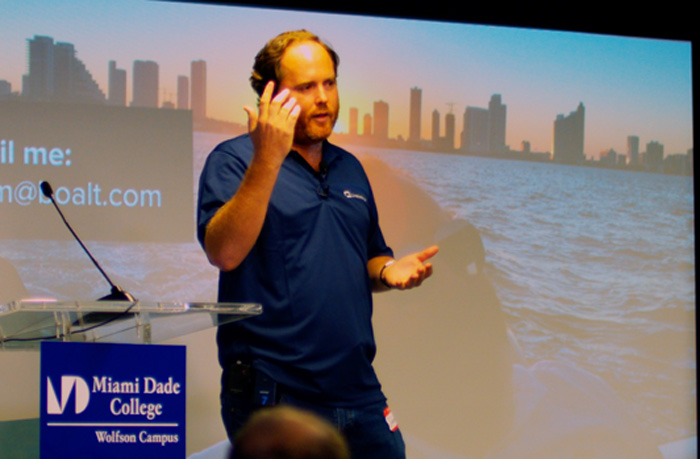 Adam Boalt, Founder, LiveAnswer (photo by Ville Ailio)
Adam Boalt, Founder, LiveAnswer (photo by Ville Ailio)
To do it right you need to dedicate 100% of yourself to your business.”
–Adam Boalt, Founder, LiveAnswer
We could not hope for a better way to seal our Summit experience with Adam’s inspiring entrepreneur’s journey. His “real talk” shed a clear light on the challenges any entrepreneur faces today without beautifying any element but showing things as they are – good or bad. From this perspective, his personal story demonstrated all the key ingredients we had talked about earlier in the day, for effective visual storytelling. It had a clear story arc (setup, conflict/s and resolution), the hero’s purpose was very clear (grow your company), the looming threats/dragons (I liked his stress meter and cash balance counter on every slide), and above all, he shared his business and personal vulnerabilities along the way – openly and candidly. These imperfections are what humanized his story and made our audience empathize with his message. Great lessons as most businesses today skip the conflict and just share their triumphs.
All in all, Summit validated the true hunger and viability of visual storytelling in empowering marketers and entrepreneurs. At the end of the day, we’re all storytellers and makers that are capable of controlling our narratives. It’s the right story and packaging that make all the difference.
Ready to unlock the power of visual storytelling and boost your marketing results? Schedule a conversation about your Visual Storytelling Workshop today!
Source: Visual Storytelling

0 Comments
Leave A Comment